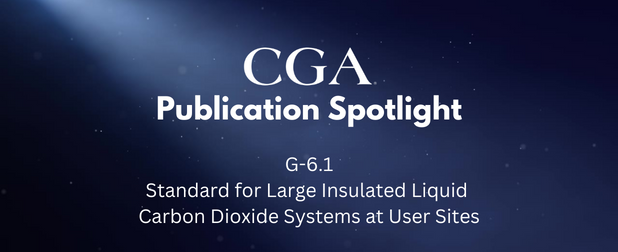G-6.1, Standard for Large Insulated Liquid Carbon Dioxide Systems at User Sites
November 16, 2022
The Compressed Gas Association (CGA) has released the eighth edition of G-6.1, Standard for Large Insulated Liquid Carbon Dioxide Systems at User Sites. This publication is one of a series compiled by CGA to meet the demand for information on the production, transportation, handling, and storage of carbon dioxide in gaseous, liquid, and solid states.
CGA G-6.1 covers the design, location, installation, operation, and maintenance of large insulated liquid carbon dioxide supply systems located at user sites. Large supply systems have a liquid capacity of greater than 1000 lb, which the industry often refers to as bulk systems.
The new eighth edition of the publication acknowledges all the hazards associated with carbon dioxide; however, this edition focuses on those associated directly with insulated liquid carbon dioxide systems. Those hazards include dry ice blocking or plugging, trapped liquid and trapped solids in the form of dry ice and water ice, the effect low temperatures have on materials, and the effect of overfilling liquid carbon dioxide into, or rapidly removing vapor from the bulk container. The publication identifies the causes of these hazards, their impact, and the mitigation activities to prevent or remediate their occurrence.
This revision has additional information on the design and construction of equipment including the bulk tank/container with numerous explanatory figures, schematics, and informative tables and charts. A detailed discussion of the container filling connections is provided. Like the last edition, extensive discussion of container pressure relief devices is provided, however this edition has additional discussion of the primary pressure relief device system design and installation considerations. This edition also includes information regarding the container refrigeration system and the vaporizer systems with discussion of purging the system periodically by a qualified carbon dioxide technician to alleviate the potential for accumulating impurities in the vaporizer. This edition includes a more in-depth discussion of the design of liquid carbon dioxide circulation loops and the materials of construction of system and the devices attached to them. The final discussion of the system equipment itself relates to internal and external corrosion allowances based on the intended use of the contained product and the tank environment
Additions have been made to the section concerned with the installation of the supply system in accordance with code requirements, including security considerations based on the product end use. This section now addresses the piping used to distribute product at the user site including the appropriate materials of construction. Inspection and testing of the installed system have been updated along with information related to the first fill of the system.
A new section associated with the sampling and testing of delivery transports at the customer site has been added with consideration of customer requirements and the safety of employees performing the offloading and testing operations
The section describing the maintenance and periodic inspection of the system has undergone a major revision and its expansion now includes what inspections should be performed daily and at other intervals as well as the documents that should be generated and maintained. The section also discusses repairs to the system should the inspection of the system indicate they are warranted.
Finally, all the references listed in the publication have been updated to reflect current standards and codes as well as other CGA publications that should be referenced.
CGA intends for this publication to serve as a guide for regulatory authorities in writing regulations and to assist designers, inspectors, and other interested parties.
In addition to the valuable information in G-6.1, to ensure personnel safety and proper system design, CGA encourages reference to CGA G-6, Carbon Dioxide, for additional information and guidance on the physical properties and common hazards associated with storage, production, transportation, and handling of carbon dioxide.


